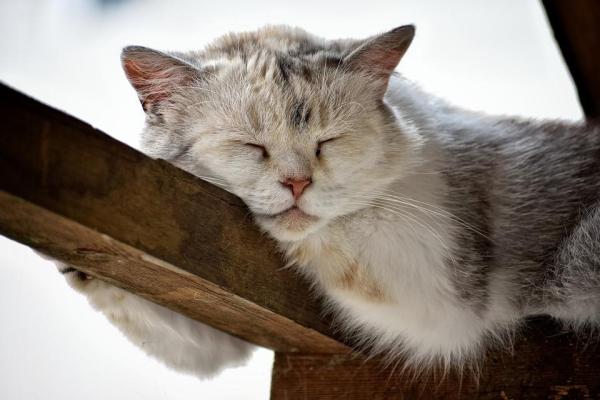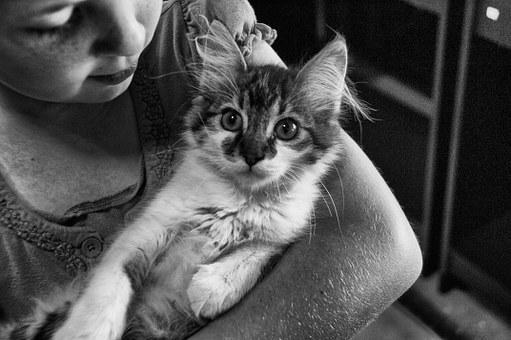
Menopause is the term used to explain the cessation of reproductive age in the human female, not something which felines will experience. There are sometimes human physical conditions which, although not biologically the same, have a parallel. Cats and humans do not have the same type of reproductive cycle, but menopause is a slowing and cessation of the reproductive cycle in humans. Humans have a menstrual cycle which ends with menopause. Cats have an estrus cycle, also known as the heat cycle in cats. If we consider it to be the ending of the reproductive cycle, we can ask do cats go through menopause?
AnimalWised answers this question by looking at when a cat ends their heat cycle. We discover how long felines are fertile and explain some of the age-related mood and/or behavior changes in cats once they get older.
Do cats go through puberty?
Menopause is the end of female fertility in humans, but it might be helpful to look at the beginning. Just like humans, cats will go through a period where they will develop and become sexually mature. This is known as puberty.
Both male and female cats will go through puberty, but only females will experience a heat cycle. This is the period during which they are periodically fertile for reproduction. Males are constantly fertile after they reach puberty.
Generally, the estrus cycle occurs between 5 and 9 months of age in short-haired breeds, which are earlier in reaching adult size[1]. In long-haired breeds, puberty can be delayed up to 18 months. The onset of puberty is also influenced by factors such as photoperiod (daylight hours) and latitude (northern or southern hemisphere).

Reproductive cycle of a cat
Female cats have a seasonal pseudopolyestrous cycle of induced ovulation. This means that they have multiple heats throughout the year, which usually start between January and February and end between June and November. As stated above, the heat cycles of cats are influenced by the photoperiod. When the days begin to lengthen after the winter solstice, their cycles begin. When the daylight hours begin to decrease after the summer, female cats begin to stop their cycles.
Induced ovulation means that the ovules (unfertilized eggs) are only released when copulation with a male occurs so they have a chance to be fertilized. For this reason, a female cat can have kittens from multiple fathers if they copulate with multiple male cats during their heat cycle. This is a process known as superfecundation. This is an effective method that nature has allowed to prevent infanticide by males, since they do now know which kittens are theirs.
Learn more about this process with our article on how long a cat is in heat.

Do cats go through menopause?
As stated in the introduction, cats do not have the same type of reproductive cycle as humans. Since menopause is the term for the cessation of the menstrual cycle specifically, cats do not go through menopause. However, we may want to know if cats go through a similar period where their estrus cycle stops and they are no longer fertile.
While age does affect a cat's fertility, they are essentially fertile for their entire lives. This does not mean an older cat is likely to give birth. Once a cat enters her senior years, they will slow down all of their behaviors, including those linked to reproduction. However, this does not mean she is not capable of having kittens. In fact, a cat known as Kitty holds the record for the oldest cat to birth kittens at a staggering 30 years of age[2].
Generally speaking, female cats will not be as interested in mating once they reach old age. This is because although they will still produce sex hormones, their body will not usually produce as much as before. Male cats will want to mate with a healthy female, so they may not be as interested in an older female cat if they think they are not as viable as a mate.
Health problems associated with old age in cats
Linked to these hormonal changes, cats may develop very serious diseases such as breast cancer or feline pyometra. Pyometra in cats is a uterine infection which is fatal if not treated correctly. This is one of the reasons why spaying a cat is seen as the only option for non-breeding cats. Spaying is the removal of the uterus and ovaries, which means the cat does not produce high levels of sex hormones as in intact cat.
Although senior cats are more prone to various diseases, problems with the reproductive system are particularly common. While they may have some benefit from being spaying later in life, it has been shown that not sterilizing cats before their first heat increases the chances of suffering malignant tumors of the breast, ovary or uterus, as well as pyometra[3]. This is especially so in certain breeds, especially various types of Asican cat breeds.
Together with all these changes, those that are linked to the aging of the cat itself will also appear. Normally, most of the behavioral changes of older cats that present are related to the appearance of diseases, such as arthritis in cats or the appearance of urinary problems. However, they can also experience neurological deterioration which can lead to something known as cognitive dysfunction syndrome. This means the cat can become easily confused and disorientated, even aggressive in some cases.
During this period, it is essential for guardians to care for their cats. If they are sexually still intact, they should be kept away from males. Even if they can fertilize their eggs, their bodies may not be in the best position to birth and care for kittens. Some may wonder if cats need a hysterectomy. Since spaying includes hysterectomy, it is something you should consult your veterinarian about. It might be beneficial to the cat, although risks will need to be assessed by the professional.

If you want to read similar articles to Do Cats Go Through Menopause?, we recommend you visit our Heat category.
1. Little S. E. (2012). Female Reproduction. The Cat, 1195–1227. https://doi.org/10.1016/B978-1-4377-0660-4.00040-5
https://www.ncbi.nlm.nih.gov/pmc/articles/PMC7158189/
2. The Guinness Book of World Records. (1996). Cats. Retrieved from:
https://archive.org/details/guinnessbook199600norr/page/62/mode/2up
3. Kustritz M. V. (1999). Early spay-neuter in the dog and cat. The Veterinary clinics of North America. Small animal practice, 29(4), 935–vii.
https://doi.org/10.1016/s0195-5616(99)50082-x